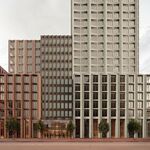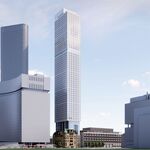JasonParis
Moderator

The promised land?
Sarah Milroy visits the 'burbs to catch a touring show determined to capture the essence of urban sprawl. She finds an astute, if unsettling, exhibit.
SARAH MILROY
January 16, 2008 at 4:23 AM EST
OAKVILLE ONT. — The exhibition Is There a There There?, the touring show on now at Oakville Galleries, takes its name from a famous remark made by Gertrude Stein regarding the subject of suburbia. In a disparaging state of mind, something of a chronic condition for American modernism's dowager queen, she said of her home town Oakland, Calif., "There is no there there." It had all the demonstrable attributes of locale, after all, and she had spent years of her life living there. Yet she found it to be devoid of a sense of place, character, presence. It was there, but it could, in fact, be anywhere.
Places like Oakland, Calif., or Richmond, B.C., or Oakville, Ont., where this exhibition is currently being mounted, share a certain sociological topography: a smattering of historic buildings progressively overwhelmed by a tide of standard issue new construction that seems the same the world over. Growth is planned and streamlined, rather than unfolding in the time-lapsed higgledy-piggledy way of yore. In some cases, whole communities spring from the ground overnight. Behind the growth is the driving engine of the real-estate industry, providing housing often for aspiring immigrant populations for whom these bulldozed farmlands and woods, stripped now to the stony soil beneath, seem like the promised land.
Many of the photographs in this astute little show - organized for the National Gallery of Canada by Oakville's Marnie Fleming - reveal that dirt as if to literally ground the viewer in something real beneath the sterile miasma of commerce. Geoffrey James's colour photograph New Housing, North of Highway 7, 11 September, 2001 captures a row of new homes in advancing stages of completion from left to right, viewed from across gouged and rutted fields bisected by mock ranch-style fencing. The shrill signage on the sales booth to the right side of the image advertises the developer's name as well as the phrases Now Open and Freehold, promising limitless freedom. A giant plywood oak leaf behind the developer's name evokes a nature now long denuded.
James took the picture in a raking morning light and, as the title points out, it was the morning of 9/11. Naming the work as he has done, the artist connects the dots for us. Urban sprawl is linked to car-dependent communities, which is linked to the squandering of resources, which is linked to the manipulation of foreign oil-producing countries by Western democracies, which is linked to terrorism.
James doesn't preach but, rather, reveals. It's as clear as the lidless blue sky overhead.
One of the pleasures of this exhibition is its resuscitation of earlier works by major artists from the National Gallery's collection that have been out of circulation for a while, such as Robin Collyer's superb series of photographs of Willowdale's commercial streetscapes from the mid-nineties, in which all the signage lettering has been digitally stripped away (the result: an eerie visual silence),Tony Brown's Untitled (Spinning House) from 1980 (the artists now lives and teaches in Paris, but was an important figure in Toronto in the eighties) and Roland Brener's Capital Z (1992), one of the late Victoria artist's most assured works.
Brener's installation consists of mock suburbs made out of cardboard. (The structures out on the fringes are mere suggestions, with the cardboard walls and roofs propped like playing cards, while the inner structures are more resolved.) These clusters are arranged around what looks like a transmitting tower, which supports a slowly rotating horizontal beam, describing slow circles in midair. In its turning, the arm of the boom connects intermittently with four metal rods that extend upward from each of these disparate cardboard communities. We hear their transmissions as they are activated - the grainy singing and chanting of the kind one would pick up on low-budget ethnic radio stations - as well as the clanging sound of construction work. It's like eavesdropping on the voices of these displaced communities, but the effect is deeply lonely and barren.
Brener's Capital Z suggests a wasteland of tenuous hopes. Again, the title is important. The word capital can denote a place, for example, a city that serves as a seat of government. But the word can also denote the stuff of pure economic exchange. What would it mean to call such a place home?
Brown's Spinning House examines the notion of home from within.
Powered by an old washing-machine motor, the kinetic sculpture consists of the wooden model of a sparsely furnished modernist suburban home that spins in hectic revolutions, receiving a series of projected images and text onto its moving surface. Some of these images appear to be of the house under construction - just the bare plywood and other raw construction materials - while others capture elements of the interior design. It's a dizzying dance of surface and depth.
Overtop, Brown projects phrases describing fragments of a typical day, interlaced with allusions to muffled emotional states: "the phone rang, lock the door, turn off the TV, detached desire, can't sleep, get up," etc. Brown captures the pace of life set on endless repeat, a whirling dervish of banality filled with busy nothing and softened by brain-dead diversion.
Many of the works here attend to the economics of suburbia, such as Roy Arden's Monster House, Coquitlam, B.C. (1996), in which a stark new Italianate McMansion overlooks the wide delta of a Vancouver suburb. This synthetic Shangri-la provides counterpoint to the ethereal beauty of snow-covered Mount Baker, which rises majestically in the distance.
Faux culture, imported from afar, is commodified and served back to the buying public, while the real indigenous properties of place are gradually upstaged, even effaced. Arden frames contrasting versions of paradise - one natural, the other man-made - and leaves you to contemplate the disparity between the two, as if to say: There was a there there, and then there was not.
Is There a There There? continues at Oakville Galleries in Oakville, Ont., (905-844-3460) until Jan. 27, and appears in Museum London in London, Ont., from April 5 to July 13.




